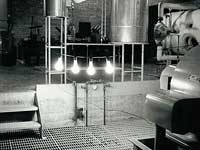Argonne's Nuclear Science and Technology Legacy
Historical News Releases
 About the Historical News Releases
About the Historical News Releases
This is an archived
Argonne News Release Item about the lab's nuclear energy legacy.
For similar items: Nuclear Energy Historical News
Releases
For more information, please contact at Argonne.
Early Argonne reactor lit the way for worldwide nuclear industry
ARGONNE, Ill. (Dec. 20, 1996) — Forty-five years ago today, a nuclear reactor produced useful electricity for the first time.
It was barely enough to power a simple string of four 100-watt light bulbs, but the 16 scientists and engineers -- all staff members of Argonne National Laboratory, which designed and built the reactor -- recorded their historic achievement by chalking their names on the wall beside the generator.
The reactor was Experimental Breeder Reactor 1 (EBR-I), housed in a small building that today still sits alone on a wind-swept plain in southeastern Idaho.
That small, isolated reactor spawned a huge international industry that now plays a major role in meeting the world's energy needs.
Today, more than 100 nuclear power plants provide 20 percent of the electricity consumed in the United States. More than 435 reactors provide some 17 percent of the world's electricity, and about 65 more plants are under construction around the world.
During its 15-year career, EBR-1 was the site of many historical firsts.

FIRST ATOMIC LIGHT — On Dec. 20, 1951, Experimental Breeder Reactor 1 (EBR-I) lighted these
four bulbs with the world's first usable amount of electricity from nuclear energy. EBR-I was
designed, built and operated by Argonne National Laboratory. Click on photo to
view a larger image.
Download image from
Flickr
The day after it generated the world's first nuclear electricity, its output was boosted to 100 kilowatts, enough to power all of its own electrical equipment. Except for normal shutdown to perform maintenance or to attend to experiments, EBR-I provided all its own electricity throughout its operating career.
EBR-I's primary experimental mission was to develop and test the concept of the breeder reactor -- a vision pursued by Enrico Fermi and his colleague, Walter Zinn, who was Argonne's first director and who led the team that built EBR-I. The idea behind the breeder is to maximize the useful energy that can be obtained from natural uranium.
Only one form of natural uranium -- U-235 -- is a useful fuel in today's nuclear reactors. Unfortunately, U-235 makes up less than one percent of all naturally occurring uranium. The rest is U-238.
But inside a nuclear reactor, U-238 atoms capture neutrons released during fission and are transformed into plutonium-239 -- a man-made element that can also fuel reactors. Thus, breeding makes it possible to use virtually 100 percent of the energy in natural uranium.
Today, the federal government sponsors no breeder research. But until a few years ago, breeders were considered the most promising way to provide the world with thousands of years of inexpensive electricity.
EBR-I provided the first proof that breeding is possible: On June 4, 1953, the U.S. Atomic Energy Commission announced that EBR-I had become the world's first reactor to demonstrate the breeding of plutonium from uranium.
Nearly 10 years later, at 2:34 p.m. (MST) on Nov. 27, 1962, EBR-I became the world's first reactor to produce electricity with a plutonium core. For the next year, the reactor provided valuable data on breeding in a plutonium-fueled reactor and helped to improve scientists' understanding of the behavior of plutonium in an operating reactor.
On December 30, 1963, its scientific mission complete, EBR-I was officially shut down.
But its story was not over.
On Aug. 26, 1966, President Lyndon B. Johnson presided over ceremonies that designated the retired reactor a Registered Historical National Monument. Before 15,000 witnesses, he said, "We have come to a place today where hope was born that man would do more with his discovery [of atomic fission] than unleash destruction in its wake."
President Johnson's words proved prophetic when earlier this month, in the true spirit of turning swords into plowshares, the U.S. Department of Energy announced plans to use excess weapons plutonium to generate nuclear electricity.
In this regard, EBR-I was three decades ahead of its time.
Related Information
- Reactors Designed by Argonne National Laboratory - Since the first day of its existence, Argonne has been at the forefront of nuclear energy research & development. Most of the reactors designed by Argonne National Laboratory were also built and operated at Argonne facilities.
Last Modified: Wed, September 25, 2013 9:25 PM


